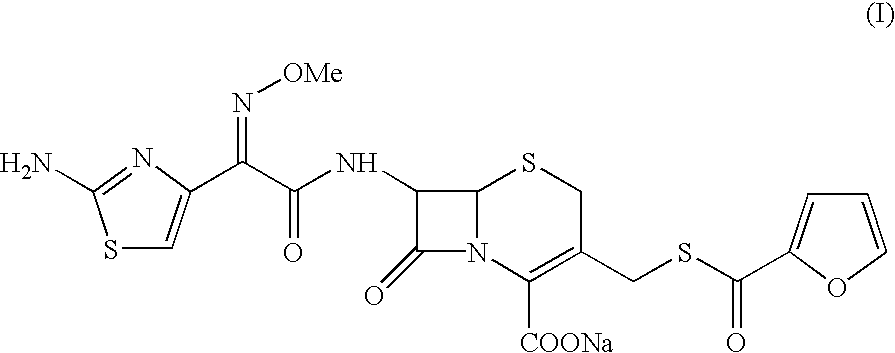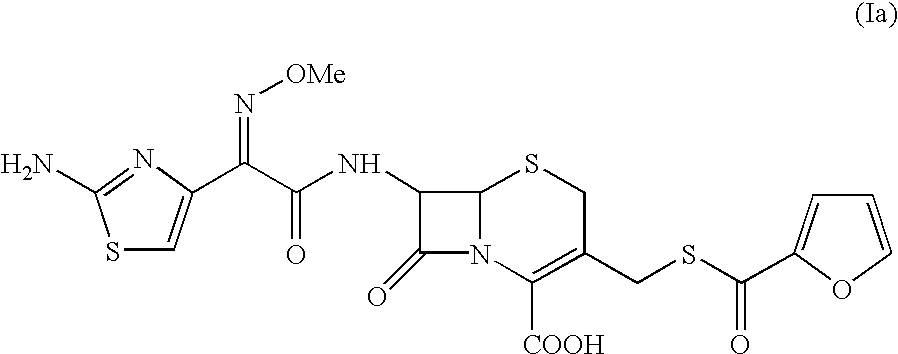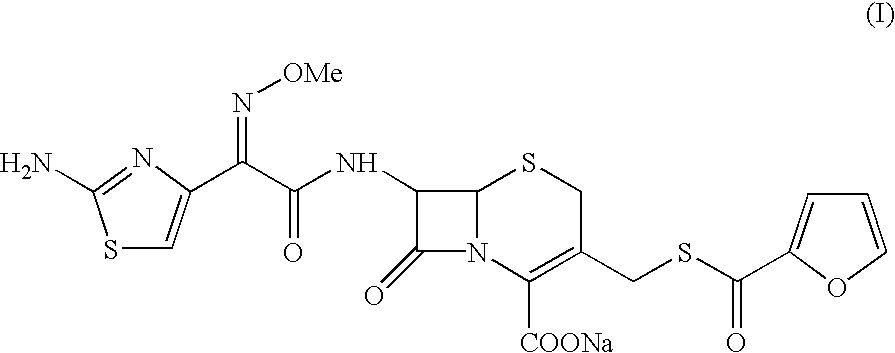Method for the preparation of ceftiofur sodium
a ceftiofur and sodium technology, applied in the field of ceftiofur sodium preparation, can solve the problems of difficult preparation of ceftiofur derivatives, and difficult purification of ceftiofur derivatives, so as to avoid product re-circulation and possible degradation
- Summary
- Abstract
- Description
- Claims
- Application Information
AI Technical Summary
Benefits of technology
Problems solved by technology
Method used
Image
Examples
example ii
Sodium 7-[[(Z-2-(aminothiazol-4-yl)-2-methoxyimino]acetamido]-3-(2-furanylcarbonyl)thiomethyl-3-cephem-4-carboxylate (sterile buffered Ceftiofur sodium)
7-amino-3-[(2-furanylcarbonyl)thiomethyl]-3-cephem-4-carboxylic acid (5.0 g) and 2-mercapto-5-phenyl-1,3,4-oxadiazolyl-(Z)-2-(2-aminothiazol-4-yl)-2-methoxyimino acetate (7.59 g) are added to a mixture of acetone (50 ml) and water (50 ml) at temperature 0-5.degree. C. The pH of reaction is maintained at 7.0 to 8.0 by addition of triethylamine during the reaction. After completion of reaction, the reaction mixture is extracted with methylene chloride (75 ml.times.3). The aqueous layer is treated with charcoal (0.250 g) and diluted with water. The filtrate is subjected to an agitated thin film evaporator working at 20.degree. C.-25.degree. C. with 15-20 mm of Hg, to get viscous slurry of Ceftiofur triethylamine salt. Sodium-2-ethylhexanoate (2.95 g) is added to the mass and the mixture is stirred vigorously. The homogeneous mixture is ...
example iii
Sodium 7-[[(Z)-2-(aminothiazol-4-yl)-2-methoxyimino]acetamido]-3-(2-furanylcarbonyl)thiomethyl-3-cephem-4-carboxylate (sterile buffered Ceftiofur sodium)
7-amino-3-[(2-furanylcarbonyl)thiomethyl]-3-cephem-4-carboxylic acid (5.0 g) and 2-mercapto-5-phenyl-1,3,4-oxadiazolyl-(Z)-2-(2-aminothiazol-4-yl)-2-methoxyimino acetate (7.59 g) are added to a mixture of acetone (50 ml) and water (50 ml) at temperature 0-5.degree. C. The pH of reaction is maintained at 7.0 to 8.0 by addition of triethylamine during the reaction. After completion of reaction, the reaction mixture is extracted with methylene chloride (75 ml.times.3). The aqueous layer is treated with charcoal (0.250 g). The filtrate is treated with sodium bicarbonate (1.5 grams) and the resulting solution is subjected to an agitated thin film evaporator working at 20.degree. C.-25.degree. C. with 15-20 mm of Hg, to get viscous slurry. This slurry is added slowly to the pool of acetone at a temperature of 20-25.degree. C., white to cr...
example iv
Sodium 7-[[(Z)-2-(aminothiazol-4-yl)-2-methoxyimino]acetamido]-3-(2-furanylcarbonyl)thiomethyl-3-cephem-4-carboxylate (sterile buffered Ceftiofur sodium)
7-Amino-3-[(2-furanylcarbonyl)thiomethyl]-3-cephem-4-carboxylic acid (30.0 g, 88.2 mmol) and 2-mercapto-5-phenyl-1,3,4-oxadiazolyl-(Z)-2-(2-aminothiazol-4-yl)-2-methoxyimino acetate (47.7 g, 132.0 mmol) are added to a mixture of dichloromethane (400 ml) and methanol (15 ml) at temperature 0-5.degree. C. Triethylamine (25.0 ml) is added to the reaction mixture in 50-60 min. After completion of reaction, the reaction mixture is extracted with water (400 ml). The aqueous layer is separated and treated with charcoal (0.500 g). Tetrahydrofuran (400 ml) and 100 g of sodium chloride is added to this solution followed by addition of (9.2 ml) of hydrochloric acid (35%). The mixture is stirred for 10 min and layers are separated. Tetrahydrofuran layer is treated with charcoal and 75 ml solution tetrahydrofuran containing 13.5 g of sodium-2-et...
PUM
| Property | Measurement | Unit |
|---|---|---|
| temperature | aaaaa | aaaaa |
| temperature | aaaaa | aaaaa |
| temperature | aaaaa | aaaaa |
Abstract
Description
Claims
Application Information
 Login to View More
Login to View More - R&D
- Intellectual Property
- Life Sciences
- Materials
- Tech Scout
- Unparalleled Data Quality
- Higher Quality Content
- 60% Fewer Hallucinations
Browse by: Latest US Patents, China's latest patents, Technical Efficacy Thesaurus, Application Domain, Technology Topic, Popular Technical Reports.
© 2025 PatSnap. All rights reserved.Legal|Privacy policy|Modern Slavery Act Transparency Statement|Sitemap|About US| Contact US: help@patsnap.com



